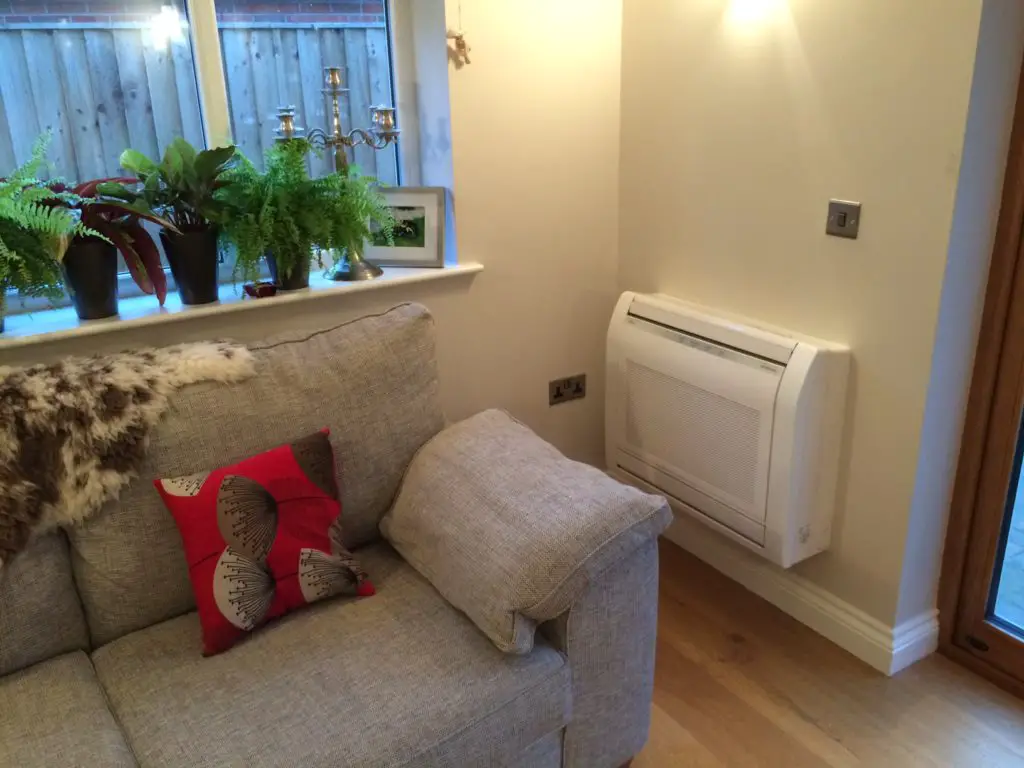
A brief story from our editor here at Heat Pumps Scotland on the experiences of a friend of his in fitting a heat pump system to a large extension.
Table of Contents
The Story
I recently caught up with an old friend whom I have known since we were at school together. He now lives in Chester and has recently completed some building work on his house.
We got chatting about his project and I was interested to hear that it included an air source heat pump. Naturally I was keen to find out more and asked him whether he would mind sending me a few photos and telling me about his experiences with the heat pump so that I could share them on the website.
He willingly obliged and I now get to share his story with you.
The Project
The project was designed to give him and his family more space in their main kitchen and dining area. Previously they were a bit cramped and had to dance around each other a bit at the busy times of day when they were all getting ready to leave the house and in the evening when they sat down to eat together.
The room was also very cold, having been done on the cheap by the previous owner who neglected to provide adequate insulation. This is something that had to change. Although it doesn’t usually get as cold as Altnaharra, Chester can get down to well below freezing in the depths of winter and my friend’s heating struggled to heat the kitchen zone of his house.
And this was the main problem, you see. The rest of the house, being better insulated, was normally quite warm, even when it was brass monkeys weather outside. The dilemma he was faced with was either to turn up the heating to warm up the kitchen and make the rest of the house uncomfortably warm, or just live with the cold kitchen. This tended to be less of a problem in the evenings when the oven and kitchen hob were adding to the overall heat in the room. However, first thing in the morning, at the time when many of us tend to feel the cold particularly keenly, the problem was especially bad.
Insulate First
One of the first bits of advice that anyone considering installing a heat pump is likely to hear is “fix your insulation first”. As a reader of this website I expect you already know this, but poor insulation will make your heat pump work far too hard to heat the room. It will be less efficient as a result and in may cases you would be better off installing a conventional boiler. By the way, condensing combi boilers are exceptionally efficient these days, achieving around 90% efficiency when new.
Being that my friend was building a new extension to make his kitchen and dining area bigger, and in the knowledge that the new part of his building would be very well insulated, he looked at the options available to him for heating.
The Options
Although this was to be an extension and therefore not benefiting from the blank slate that a new build would offer (ground source heat pumps often make it to the short-list with new builds), there were still plenty of options to choose from. The way his family was planning to use the new space meant that they would often have a need to boost the temperature in the kitchen dining room without wanting to heat the rest of the house. One option might be to install an Aga, but that would have been on all the time and his house is typically not occupied during the day while the family are out at work and school. That would be a lot of money spent heating an empty house.
Another option could have been a gas fire or wood burning stove but these were ruled out because of the space they would have taken up and also due to safety concerns with the possibility of young children burning themselves on the hot surfaces.
Heat pumps appeared to be a strong option because they can achieve very high efficiency, do not have the same safety issues as open fires or wood burning stoves and are very controllable. The advantages of heat pumps over these other options convinced him that would be the right choice.
The choice was therefore between a ground source heat pump and an air source heat pump. There was no river or pond nearby so water source heat pumps were a non-starter. A ground source heat pump was ruled out because of the disruption digging up the garden and the fact that it would have been overkill for the minor heating issue that was being faced. For these reasons, the decision was taken to go with an air source heat pump.
The Result
In the end, he went for a Fujitsu Inverter model (the Fujitsu R410A to be precise) and is very pleased with the result. In the morning, the first person up and into the kitchen flicks the heat pump on for a few minutes and by the time the cereal is in the bowl, the room is “toasty warm”.
Not only is my friend and his family now nice and warm on those cold winter mornings, but their fuel bills are reduced, despite having increased the size of their home.
As you can see from the pictures below, the heat pump fits unobtrusively into their living space and quietly does its job.
If you have any questions about this little story, let me know and I’ll do my best to answer.
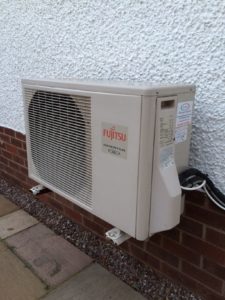
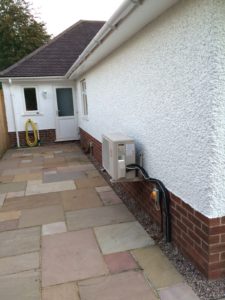
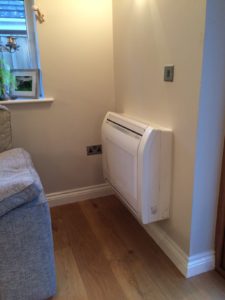
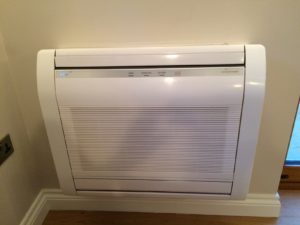
You might also be interested in the case study in Scotland where a ground source heat pump was retrofitted to a tower house with amazing results.